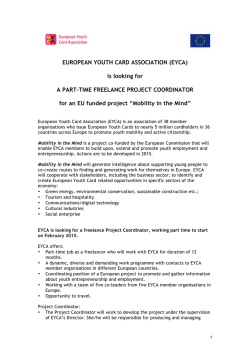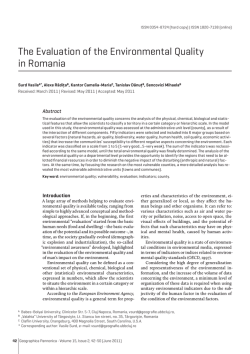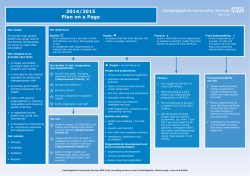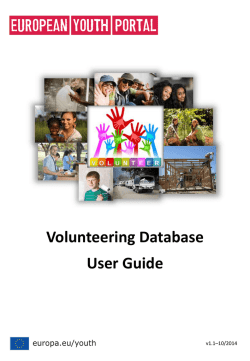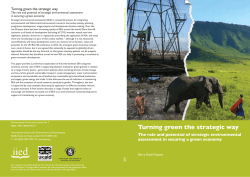
SEA
A Systems Approach to SEA Effectiveness NCEA/ISBN 978-90-421-9454-0 3 February 2014 Prepared by the Netherlands Commission for Environmental Assessment Table of Contents 1. INTRODUCTION ...................................................................................................2 2. CHARACTERISING THE SYSTEMS APPROACH TO SEA EFFECTIVENESS ....................3 2.1 Better SEA systems: How to measure improvement? ................................... 3 2.3 Better SEA processes: When has an SEA improved? ..................................... 7 2.2 3. APPLICATION OF THE SEA SYSTEMS APPROACH IN PRACTICE ................................8 3.1 Links between SEA system, capacities and individual SEA cases .................. 8 3.2 How does NCEA apply the systems approach in practice? ........................... 9 3.4 Using the indicators to measure the NCEA’s performance......................... 11 3.3 4. More SEA capacity: How to determine when it is sufficient? ........................ 5 Opportunities and threats: Cooperation activities in their context ............ 10 THE PERFORMANCE INDICATORS .......................................................................11 4.1 SEA performance indicators – System level ............................................... 12 4.3 SEA performance indicators – Level of individual SEAs (process) ............... 19 4.2 SEA performance indicators – Capacity level ............................................. 17 -1- 1. Introduction The Netherlands Commission for Environmental Assessment (NCEA) has been involved in Environmental Impact Assessment (EIA) and Strategic Environmental Assessment (SEA) practice in the Netherlands for over 25 years, and in international cooperation for 20 years. Within the Netherlands, the NCEA provides independent quality assurance and operates as an EIA/SEA knowledge centre. Outside the Netherlands, the NCEA supports EIA/SEA capacity development, in addition to advice on quality assurance and knowledge sharing. The NCEA makes its knowledge, experience and lessons learned available to its direct partners, and to a wider audience of EIA/SEA practitioners, scientists and the general public, through a variety of channels: the NCEA website, newsletters, the NCEA-Views & Experiences series, (joint) publications and key sheets. This publication introduces the reader to an ambitious endeavour the NCEA has embarked on in 2012: the translation of its practice experience into a so-called systems approach. This approach is intended to be used both for analyzing existing EIA and SEA systems in the countries with whom the NCEA cooperates, as well as for measuring the results of the contribution that the NCEA makes to improving these systems. The system approach has been developed for both EIA and SEA. This publication, however, concentrates solely on SEA, in a separate publication the systems approach is detailed for EIA 1 . Below, in chapter 2, the systems approach is further explained. In chapter 3 we set out how we apply this approach in practice. The last chapter contains a series of tables with a detailed overview of the SEA system results, and the indicators and means of verification we have defined for the systems approach. It is important to emphasise that this systems approach to EIA and SEA is a work in progress. We expect to adapt the approach as we gain practical experience with this way of working, and in response to feedback we receive from the partners we work with. A new edition of this publication will be prepared when our understanding of the systems approach has evolved further. 1 See: NCEA, 2014, A systems approach to EIA effectiveness. -2- 2. Characterising the systems approach to SEA effectiveness In its international work, the NCEA strives to contribute to ‘better SEA systems, more SEA capacity and better SEA processes’ in the countries with which it cooperates. In 2012, we were challenged by the Dutch Ministry of Foreign Affairs, which subsidizes the majority of our international programmes, to make these objectives more tangible and measurable. In response, the international section of the NCEA made an effort to translate the lessons learned from practice into the ‘SEA systems approach’ presented here. Starting point for this approach is the idea that if we want to understand SEA effectiveness, we need to take into view the whole SEA system, rather than looking solely at different components such as SEA regulation. We distinguish three levels in our systems approach: the system level (2.1), the organisation level (2.2) and the process level (2.3). At the system level we look at key functions that should be fulfilled within a system to enable good practice SEA. The organisational level is about the capacities of actors that have a role in the SEA system. At the process level, we look at how individual SEA processes are undertaken. In keeping with the overall NCEA objective to contribute to ‘better SEA systems, more SEA capacity and better SEA processes’, we have identified key results that should be achieved at each level. Each result is subsequently translated into a set of indicators, including the means of verification that allow assessment of the progress on that result. More detail is provided in chapter 4. In most cases, the assessment is qualitative, although some indicators are assessed quantitatively. Note that, in some instances, the means of verification refer to separate methods that the NCEA has developed, or which are currently under development. These methods are not elaborated in great detail in this publication, but more information is available elsewhere (see www.eia.nl). 2.1 Better SEA systems: How to measure improvement? The NCEA defines an SEA system as a coherent set of ‘functions’ that are necessary for effective SEA practice. The system can be considered to be improved, when one or more of these functions have been strengthened. An SEA system is generally bounded by country borders, but in a country where SEA is decentralised, the system could also be specific to a province or district. Similarly, where countries have co-ordinated their SEA approaches, a supra-national SEA system could be considered. At system level, we have identified six key functions. See figure 1 below. -3- Figure 1 In the view of the NCEA, these six functions need to be fulfilled for an SEA system to be effective. For each of the six functions we have formulated the results that we would hope to see as we work with partners to ensure that each of the functions is operational within their SEA system. For each result we have defined a set of indicators to measure progress on these results, as well as means of verification. For example: 2 Function: Raise awareness, commitment and funding for SEA. Result: SEA is on political agenda and high level decision-makers are involved in SEA practice Indicator: Government has explicit policy on development of SEA instrument (yes/no) Indicator: Nr. of times SEA appears on relevant agenda for Cabinet meetings, or other relevant agendas Indicator: Nr. of intervention moments by decision-makers in individual SEA processes Means of verification: Reporting by partner organisation The six functions all together contribute to the overall SEA system performance in terms of the number and quality of SEAs that are produced. To track this performance, we have also defined specific system results that the NCEA wants to contribute to, as well as indicators and means of verification for these. 2 See chapter 4 for all six functions and all corresponding results and indicators. -4- Result: Improvement in SEAs quality (yes/no) Indicator: Proportion of SEAs considered of sufficient quality Indicator: Proportion of SEAs considered influential (on decision-making and implementation) Means of verification (for both indicators): Analysis of SEA sample and/or interviews (for example, with those responsible for SEA review) 2.2 More SEA capacity: How to determine when it is sufficient? Capacity development at organisation level It is essential for the effectiveness of an SEA system that the organisations that have a responsibility in this system have the capacity to perform the role they have. This applies both to governmental organisations with formal roles in the system, and to non government organisations that have more informal roles, such as NGOs and Universities. In the NCEA systems approach, the roles of organisations are related to system functions. See figure 2. Note that we use the term organisation loosely. For example, a network of actors such as that of consultants that undertake SEAs is included here as an organisation that contributes to SEA system functions. Figure 2 NB: The illustrated relations and organisations in this figure are an example, the nature of the organisations and their contribution to system functions will vary depending on the context of a country. -5- But what does ‘capacity’ mean in this context? And when can it be concluded that an organisation has sufficient capacity? To address this issue the NCEA benefits from the results of a major research project undertaken by the Inspection Development Cooperation (IOB - a department of the Ministry of Foreign Affairs) 3 . In this research, seven Dutch organisations that are involved in capacity development in international cooperation - including the NCEA – were evaluated on their effectiveness. From the evaluation it was concluded that any effective organisation needs to have five ‘capabilities’, together making up the ‘capacity’ of an organisation or network of actors. The five capabilities (which could also be seen as effectiveness criteria for organisations) are: - The capability to act: For example, does the organisation have a clear mandate for what it tries to do? Is there strong and effective leadership in the organisation? Etc. - The capability to achieve results: Does staff have sufficient skills? Does the organisation have sufficient budget? Etc. - The capability to relate: Does the organisation have access to an effective network? Does it effectively manage its relations? Etc. - The capability to be consistent & coherent: Does the organisation have a clear vision of where to go to? Does it have effective procedures instructing staff what should be done under which circumstances? Etc. - The capability to adapt & renew: Is the organisation capable of learning? Is it flexible enough to adapt to changing circumstances? Etc. To strengthen the capacity of the organisations that have a role in the SEA system, the NCEA needs to consider these five capabilities. For each of these five capabilities, the NCEA has formulated SEA specific indicators and means of verification. For example 4 : Capability: Capability to commit and act Indicator: Mandates clearly defined in legal texts (yes/no) Means of verification: Analyses of legal texts. Capacity development of persons within organisations Traditionally, some of the activities of the NCEA are targeted towards individuals, oftentimes a small selection of individuals from different organisations. These activities are geared towards supporting individual professional development to enable SEA professionals to perform their specific tasks within the organisation or network that they operate. This usually involves training and/or coaching, often (preferably!) as components of organisational capacity development interventions. For this reason, the NCEA has also identified a set of indicators that can track progress in capacity development at the level of an individual person. These are also further described in Chapter 4. In its work the NCEA aims to help organisations across the five capabilities, as well as strengthening capacity of individuals within organisations. The capacity of an organisation is considered to have improved, if an organisation within the SEA system scores better on the indicators for one or more of the five capabilities and/or the indicators for individual capacity. 3 IOB evaluation No. 335: Facilitating resourcefulness. Evaluation of Dutch support to capacity development (2011). 4 See for all six functions and all corresponding results and indicators p. 18. -6- 2.3 Better SEA processes: When has an SEA improved? Together the SEA organisations identified have the capacity both to run an effective SEA system, and to deliver effective SEA processes. See figure 3 below. Figure 3 NB: The illustrated relations in this figure are an example, the nature of the organisations and their contribution to system functions and to the SEA process will vary depending on the context of a country. For the process level the NCEA formulated the following five results that identify an effective SEA process: - Good quality of the SEA report and process - Improved quality of the decision making process - Improved sustainability of the adopted policy, plan or programme - Improved quality of decision making at other levels, e.g. on EIAs or within other sectors - Improved capacity of organisations (through training on the job) In the same way as for the system and organisation levels, we have formulated indicators and means of verification for each result. For example: Result: Good quality of SEA report and process Indicator: Assessment complete and of appropriate scope (yes/partially/no) Means of verification: NCEA review of SEA report -7- To assess the results of its efforts at the level of an SEA process the NCEA looks at both the ‘product’ (SEA report) and the ‘process’ (SEA process, including follow-up). Within the means of verification we make use of monitoring forms that NCEA has developed earlier as part of its internal monitoring system. 3. Application of the SEA systems approach in practice 3.1 Links between SEA system, capacities and individual SEA cases Different organisations or networks of actors contribute to different functions within the SEA system. Sometimes, one specific organisation has a dominant role in one function, such as a Ministry of Spatial Planning might have in providing a regulatory framework for SEA. In other cases, more organisations or actors contribute to a function. For example for the function Raise awareness and commitment for SEA, the same Ministry will be relevant, but a body like a Council for Sustainable Development can also play a role. The capabilities of an organisation or actor determine how well the actor is able to contribute to a system function. Figure 4. illustrates the relationship between system functions and organisation. It depicts a possible outcome of an analysis of a given SEA systems functions and organisational capacity The coloured circles with a “c”, stand for the capabilities singled out for strengthening in a possible cooperation programme with the NCEA, see also 3.2. Figure 4 -8- 3.2 How does NCEA apply the systems approach in practice? The SEA system approach can provide a useful framework to analyse a countries SEA system and identify those elements that need strengthening. When a multi-annual cooperation programme is being formulated, the NCEA usually starts with such a system-wide assessment. Together with our partners, we discuss the different functions that should be contained within an SEA system. Jointly it is then decided which functions need to be established or improved. In the next step, the organisations or actors are identified that play a role in these functions. Depending on where possibilities for cooperation emerge, the NCEA starts working on the functions that have priority with the organisations that are interested in cooperation. When the NCEA starts a cooperation process with an organisation, this organisation is subsequently analysed according to the five capabilities (see 2.2). Together with the organisation, an action plan or programme is then developed to strengthen that particular organisation. The cooperation programme addresses one or more of the organisations’ capabilities (see for example the coloured circles within the Ministry of Planning box in figure 4 above). Of course, it is rarely possible to take on all the capacity needs within a given SEA system simultaneously. Choices have to be made depending on the scale of the cooperation and who the willing partners for cooperation are. Often the NCEA will work specifically with the organisations and capabilities that are more directly related to SEA. In most cases, the activities supported by the NCEA concentrate on one or two levels of the SEA system, but can lead to results at other levels. For instance, NCEA advice on a specific SEA case may lead to changes in working procedures within an organisation or may lead to improvement in political commitment to SEA. Similarly, as the NCEA partners strengthen their own capabilities, the system functions to which the partners contribute should also improve. In box 1 below, we illustrate how the SEA system approach influenced the design of a two year cooperation project in Macedonia 5 . 5 See: NCEA, 2012, Success Factors for SEA Capacity Development: the Macedonia Case, In: Views and Experiences 2012, Netherlands Commission for Environmental Assessment, Utrecht, the Netherlands. -9- Box 1. SEA systems approach in Macedonia In 2010 a government-to-government cooperation started between the Macedonian Ministry for Environment and Physical Planning and the NCEA. In the early stages of the project, the Macedonian and Dutch counterparts jointly analysed the SEA system. Firstly, they identified the various functions that need to be fulfilled within the Macedonian SEA system. Secondly, they looked at the key actors within this system, and how they contributed to different system functions. For example, all SEA systems require a steady influx of young SEA professionals. In Macedonia too, there need to be training opportunities for people who are interested in this field (system function “Provide SEA education and professional training”). The question was, who should be offering such training, and how to ensure that it is structurally available? The ministry counterparts decided that in Macedonia it should be the universities and the training institute for government staff that provide education and training. For the system function “Raise awareness and (political) commitment”, a high-level champion of SEA within the administrative or political system is needed. Here, the SEA staff of the ministry thought that the Council for Sustainable Development could contribute to this function. For the system function “Advise on SEA procedure and practice”, the ministry staff concluded that they themselves should be primarily responsible and that the Ministry should house a help-desk function. Certified SEA consultants could advise in specific cases. This way the systems analysis helped the ministry to determine which functions within the SEA system required attention in the cooperation with the NCEA, and how the ministry should organize itself to effectively contribute to these functions. 3.3 Opportunities and threats: Cooperation activities in their context The NCEA’s systems approach can help to identify opportunities for SEA strengthening, to jointly decide on ambitions for change, and to define the results that partners want to achieve with the NCEA’s support. Conversely, the systems view might also highlight impossibilities. For example, if the systems analysis shows specific functions or organisational capabilities to be a clear bottleneck for performance of the system, and there is little scope to change those, then the NCEA may opt to postpone cooperation activities until a more opportune time. In addition, jointly with our cooperation partners, we will try to assess the context of an SEA system to figure out if the cooperation activities are suitably timed. What is the political agenda? What is the administrative culture? Who has the power? The answers to these kinds of questions help to determine whether the proposed activities are likely to be successful in the given context. If important contextual factors are likely to be restrictive, the cooperation activities may need to be reconsidered. -10- 3.4 Using the indicators to measure the NCEA’s performance As stated before, the original incentive to formulate the SEA system approach was a request by the Dutch Ministry of Foreign Affairs to render the results of the NCEA’s work more tangible and measurable. We have experimented with the systems approach in the NCEA working programme for 2013. The intended results of planned activities were formulated along the lines of the criteria and indicators in the systems approach. The approach proved suitable for this use. The NCEA team is positive that the approach will also serve as a valid framework for measuring results during and at the end of a cooperation project. However more practical experience is needed to support this expectation. Clearly, we will carefully need to focus our use of the performance indicators for each application. After all, in our country programmes we seldom work with all institutions relevant for the SEA system, or each of the six functions of the system. So each time the NCEA will be following a limited set of results that relate to the activities that are relevant within a specific cooperation project or programme. 4. The performance indicators In the tables on the next pages, the performance indicators are elaborated, for each of the levels (system, organisation and process). Note that the means of verifications are lined up with the indicator for which they are intended. If not, then the means of verification can be used for more than one of the indicators listed under that result. If there is a reference to “partners” under means of verification, we are referring to our country partners in our cooperation activities, such as a Ministry for Spatial Planning -11- 4.1 SEA performance indicators – System level Function: Provide regulatory framework for SEA Results Indicators Means of verification SEA regulation is in place SEA regulation established (yes/no) SEA regulation is of sufficient quality Quality assessment against good practice benchmark: Assessment of regulation (of regulation changes) Document analysis (sources: govt reporting) interviews Scope of application consistent with ambition and capacity against benchmark (checklist approach – (yes/no) on Sufficient scope of assessment (including strategic alternatives) each aspect supported by qualitative statement) Participation included SEA quality control included Accountability sufficiently addressed Clear roles, mandates & co-ordination arrangements Sufficient arrangements for compliance and enforcement SEA guidance exists, is widely accessible, and Guidance exists (yes/no) Document analysis (sources: govt reporting) of sufficient quality Estimation of % practitioners that have access to guidance Interview with (panel of) practitioners Combined result of assessment quality against good practice Quality assessment of guidance benchmark: Guidance developed in iterative and consultative process Guidance appropriate for level and nature of practice Guidance is practical, includes case illustrations Guidance makes use of existing (international) resources -12- Function: Raise awareness and commitment to SEA, including funding Results Indicators Sufficient budget is allocated to undertake SEA related tasks at relevant organisations, such as Ministry for Environment (differenti- Earmarked SEA budget in governmental budgets exist (yes/no), Budget available for individual SEA cases: (yes/no), rough estimate budgets & trends, budget considered sufficient? Level of media coverage on SEA Interviews and (if available) analysis of govt budget rough estimate budgets & trends, budget considered sufficient? ate between donor and country budget) SEA is given attention in the public domain Means of verification Interviews with panel of SEA consultants Media analysis, or more anecdotal (partners collect “cuttings”) SEA is on political agenda and high level Government has explicit policy on development SEA instrument Reporting by partner (yes/no), decision-makers are involved in SEA practice Other agencies have explicit policy (yes/no – and nr. of policies) Nr. of times SEA appears on relevant agenda for Cabinet meetings, or other relevant agendas, etc Nr. of intervention moments by decision-makers in individual SEA processes Nr. of times decision-makers physically present at SEA related events Sufficient level of interest and participation in SEA related events (seminars, etc) Recognizable, accepted, and effective leader- Turn-out: Nr. of participants, and ratio target audience versus Reporting on events who attended Appreciation for event Feedback participants (forms etc) Level of questions and discussion (basic/advanced) Analysis/interview organizers SEA practitioners can identify SEA leaders pushing/motivating Interviews with panel of SEA practitioners better practice when asked (yes/no), ship on SEA Estimation of how effective/influential SEAs are (% of total SEAs)? -13- Function: Provide SEA education and professional training (NB: education = tertiary level SEA teaching at academic institutions, training = professional development) Results Indicators SEA education is available Curricula established at teaching institutions (yes/no) Nr. of degree programmes where SEA is taught Nr. of institutes where SEA is taught with good reputation (aca- Internet search demic ranking) Interviews Participants/students are able to contribute to good practice? Interviews with panel of SEA practitioners SEA education is of sufficient quality Means of verification Internet search (+interviews if needed) SEA teaching is co-ordinated or under quality control (unified curriculum etc) (yes/no), (yes/no) Analysis existing evaluations High scores on education participants evaluations Interviews with ex students Professional training is available (i.e. indicator Training available (yes/no) Internet search is not about one-off training but about regu- Nr. of SEA training opportunities on annual basis (workshops Interviews with panel of SEA practitioners if larly organized workshops etc for SEA profes- etc. available) needed sionals to further develop their skills& knowledge) Function: Provide advise on SEA procedure and practice (SEA helpdesk) Results Indicators Means of verification Helpdesk for SEA established, accessible and Helpdesk established (yes/no) used Nr. of queries received Helpdesk effective in influencing practice Level of effectiveness (%) allocated by practitioners Partner reporting (tracking system helpdesk and/or interview with helpdesk experts) -14- Interviews with (panel of) SEA practitioners Function: Monitor implementation of SEA Results Indicators Adequate monitoring of SEA implementation Monitoring activities are undertaken (yes/no) Document analysis takes place Budget is available for monitoring (yes/no) Interviews (Public) reporting on progress takes place (yes/no) Monitoring leads to SEA improvement efforts Means of verification Nr. of actions undertaken on monitoring conclusions (feedback and Document analysis follow-up) Interviews Results Indicators Means of verification Professional exchange platform is established Platform exists (yes/no) Partner reporting and operational Average turn-out for activities (nr. or high/medium/low) Interviews with (panel of) SEA practitioners Level of activity (nr. of events or high/medium/low) % effective in influencing practice Network recognizes and promotes good practice (yes/no) Function: Enabling professional exchange -15- The six functions above together contribute to SEA system performance in terms of the number and quality of SEAs. System performance is tracked through the results and indicators below. Note that the results are now formulated in terms of relative changes rather than as absolute qualities. This is because the determination of what constitutes sufficient quality of SEA practice, adequate level of SEA application or a good practice SEA, will be relative to the starting point in the system concerned, as well as on the ambitions set for that specific SEA system. Results Indicators Means of verification Improvement in SEAs quality Proportion of SEAs considered of sufficient quality Analysis of SEA sample and/or Proportion of SEAs considered influential (on decision-making Interviews (for example, with those responsible and implementation) for SEA review) More co-ordination between governmental % cases that other govt agencies/departments are consulted in agencies takes place within SEA processes screening, scoping etc (estimate) Improved application of SEA (Note: depending Nr. of SEAs undertaken annually Interviews SEA tracking system (partner responsibility) on ambitions for SEA, in some cases lower nr. of SEAs over time could signal an improvement) -16- 4.2 SEA performance indicators – Capacity level Capacity of specific actor (such as an SEA department in an Ministry for Environment, or a lead agency in planning processes subject to SEA) Result Indicators C1: Capability to commit and act Means of verification Mandate clearly defined in legal texts (yes/no) Analysis of legal texts Interviews (separately with management (concerns legal basis for commitments, ability Decisions are taken, communicated and acted upon (yes/no) to plan & take decisions in concerted way, Organisation has committed and stable leadership (yes/no) leadership) Organisation has clear and functional organisational structure (yes/no) C2: Capability to deliver (concerns technical Structural financing secured to execute mandate (yes/no) State budget/organisations budget knowledge to perform tasks, access to exter- Offices established, facilities and equipment needed available (yes/no) Human resources policy nal knowledge, resource base) Nr. of staff available sufficient to perform tasks (nr.) Workload calculations Expertise available fit to perform tasks (can be split into indicators for and work floor) Interviews (separately with management and work floor) specific tasks relevant for organisation, depending on role of the actor in the SEA system, i.e. SEA screening, organizing multi-actor planning processes) (yes/no) Finances and mechanisms available to access external expertise if needed (specifically for SEA review) (yes/no) C3: Capability to relate to external stakeholders (concerns networks and relationships) Co-ordination/cooperation with relevant partners takes place (specifically for SEA processes) (yes/no)) Organisation has political and social legitimacy (yes/no) Leadership in SEA organisation duly recognized by partners (yes/no) Platforms/networks/coalitions for exchange (both national and international) identified by organisation, and organisation (pro)actively partici- -17- Interviews (separately with people inside and outside the organisation itself) Organisation willingly shares information (yes/no) C4: Capability to adapt and self-renew Management encourages exchange and learning (yes/no) (concerns learning, and responding to chang- Staff regularly trained and effort made to maintain expertise for tasks ing context) Interviews (separately with management and work floor) (yes/no) C5: Capability to maintain coherence Management anticipates new developments (yes/no) Vision/Strategy/multi-annual plan exists and informs the work of the (concerns vision, working procedures) organisation (yes/no) Document analysis (including guidance documents) Vision/strategy/planning documents accessible to and known by lower IMS 6 /data base analysis levels, too (yes/no) Interviews (separately with management and work floor) Information management system exists giving access to information required to perform tasks (yes/no) Tools/guidance available to support tasks (working procedures, checklists, etc) (yes/no) Regular planning/ coordination meetings are held (yes/no) Capacity of specific individual to perform his/her SEA related task Result Indicator Means of verification SEA Professional fully capable of Knowledge & expertise needed to perform task sufficient & up to date (yes/no) Training evaluation results performing task Person feels confident to perform task (yes/no) Coaching reports Access to knowledge and information secured (yes/no) Evaluations of quality of work Position of staff duly recognised and respected (yes/no) Interviews Enabling atmosphere to openly exchange and discuss (yes/no) Analysis of decisions Leadership respects and defends staff technical stand points (yes/no) 6 Information Management System. -18- 4.3 SEA performance indicators – Level of individual SEAs (process) These indicators have been designed to assess the results of the NCEA’s advisory work in concrete SEA processes and can be used to track the results of the NCEA’s Terms of Reference (ToR) and SEA review advice, as well as to coaching. Note that M1, M2 and M3 denote monitoring forms previously developed within the NCEA. The forms are designed to collect monitoring information on results achievement. Result Indicator Means of verification Improved SEA report and process NCEA advice followed (yes/partially/no) Assessment complete and of appropriate scope (yes/partially/no) Alternatives identified and compared and led to recommendation for plan NCEA review of SEA report (when relevant) M2 form administered as interview and/or written questionnaire (yes/partially/no) SEA covers how risks can be addressed in plan implementation (yes/partially/no) Key stakeholders in plan involved in all of the above? (yes/partially/no) SEA integrated into plan process (in terms of different process steps, SEA team/plan team working together, combined SEA and plan public meetings?) (yes/partially/no) Improved decision-making on plan Formal decision (adoption of plan) made (precondition indicator) (yes/no) SEA recommendations taking into consideration in the plan deliberations or in decision statement (yes/partially/no) M3 form administered as interview and/or written questionnaire Decision analysis Support/awareness for plan increased through SEA (more participation/transparency of plan process) (yes/partially/no) More sustainable plan New alternatives incorporated into plan (yes/partially/no) Follow-up interview(s) to update M3 Mitigation measures incorporated into plan design or implementation plan form, with focus on implementation (yes/partially/no) Stakeholder concerns incorporated into plan (yes/partially/no) SEA facilitated coordination between govt. agencies (yes/partially/no) -19- Project is more environmentally friendly (see MDG references in M3) and socially acceptable (yes/partially/no) Institutional arrangements (monitoring plan, capacity, etc) to deal with environ- Relevant staff exposed to/participated in new way of working (Nr. of relevant people mental risks during plan implementation are planned or in place (yes/partially/no) Improved capacity (if SEA had additional aim of learning, such as joint review Interviews participated in counterpart team) with counterpart team to demonstrate Way of working incorporated in own practice (yes/partially/no) how to do review or by involving ex- Case used for training/education or as practice benchmark (yes-no) Satisfactory advice has been delivered Level of satisfaction on content of advice (high/medium/low) M1 form administered as interview and has led to concrete action Level of satisfaction on timing of advice ((high/medium/low) and/or written questionnaire Distribution of advice (% stakeholders involved in drafting advisory ToR versus perts (e.g. Dutch and local water expert)) stakeholders having received final ToR Adoption of advice (yes/partially/no) Concrete actions on advice taken (consider specifically any change in budget allocated to SEA) (yes/no) Improved planning overall SEA influenced other levels of decision-making (i.e. other plans, SEA based project decisions) (yes/partially/no) -20- Follow-up interviews
© Copyright 2025
